People experience anxiety around money issues, such as financial services and health insurance. And while they look for advice from others in such situations, says a paper from the Harvard Business School, being responded to by a chatbot instead of a human can drive their anxiety even higher.
Yet if given the choice of talking to a human or a chatbot, most opt for the bot — despite the fact that their very anxiety surrounding the situation in which they find themselves (the situation that is prompting their quest for advice) has a negative effect on customer choice satisfaction, firm trust and long-term engagement.
Recommended For You
Want to continue reading?
Become a Free PropertyCasualty360 Digital Reader
Your access to unlimited PropertyCasualty360 content isn’t changing.
Once you are an ALM digital member, you’ll receive:
- Breaking insurance news and analysis, on-site and via our newsletters and custom alerts
- Weekly Insurance Speak podcast featuring exclusive interviews with industry leaders
- Educational webcasts, white papers, and ebooks from industry thought leaders
- Critical converage of the employee benefits and financial advisory markets on our other ALM sites, BenefitsPRO and ThinkAdvisor
Already have an account? Sign In Now
© 2025 ALM Global, LLC, All Rights Reserved. Request academic re-use from www.copyright.com. All other uses, submit a request to [email protected]. For more information visit Asset & Logo Licensing.









